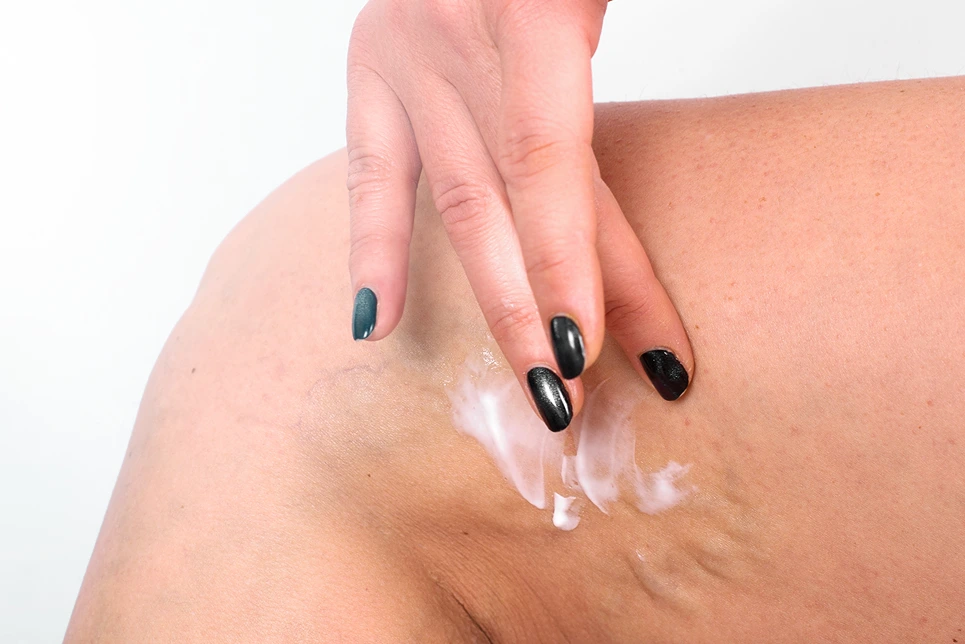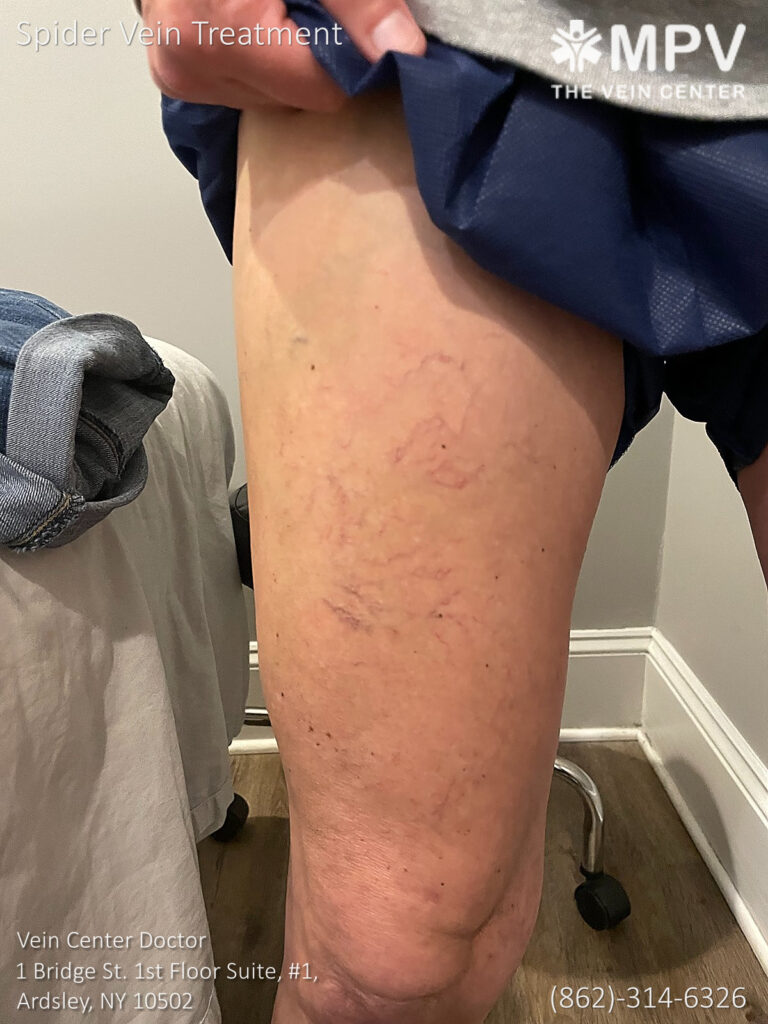Laser treatments for spider veins are a game-changer, but let's face it, the idea of a laser on your skin can be unsettling. How do you make an effective procedure also comfortable?
Enter numbing creams. They're the behind-the-scenes heroes, ensuring the journey is as smooth as the results. You've heard about the transformative power of lasers, but are you aware of the silent comfort these creams provide?
Living with unwanted veins is a thing of the past, when you can simply schedule a free consultation with Vein Center Doctor and find your ideal solution today.
Found predominantly in the legs, these minuscule veins might not be a health menace, but they often become an aesthetic concern.
Many people view them as unsightly interruptions on their skin's canvas and seek treatments to diminish or eliminate their presence.
Laser treatment presents a popular solution in the world of spider vein remedies. So, how does it work?
Think of a laser as a precision tool that emits a concentrated beam of light. When directed at spider veins, it encourages blood clots to form, effectively shutting down these small vessels.
The result? Over time, these treated veins fade away, leaving clearer skin in their wake.
If you're contemplating laser treatment, here's the good news:
While laser treatments have their pros, it's crucial to be aware of the potential cons. Here's what might be on the horizon post-procedure:
But remember, choosing a seasoned dermatologist, one who's well-acquainted with the nuances of your skin, can drastically reduce these risks.
Numbing creams, sometimes referred to as anesthetic creams, are often applied prior to laser therapies to alleviate any mild discomfort during the procedure. It helps numb the area, ensuring that the pulses of laser energy are more bearable.
At their core, numbing creams contain local anesthetics—chemical agents that temporarily block pain signals from traveling to the brain. They're like messengers that have decided to take a short break. So, even if there's a sensation (maybe from a needle or a laser), the brain doesn't decode it as pain.
Here's how the magic unfolds:
Word of Caution
Just a heads up: Always use numbing creams wisely and under professional supervision. They're effective, sure, but misusing them can lead to some unwanted after-effects.
And always remember, while the numbing cream ensures comfort, the laser treatment's success hinges on multiple factors. The cream just ensures you're cozy while the laser gets to work.
The potency and effectiveness of a numbing cream heavily rely on its active ingredients. Some of the stars in this category are:
Understanding the onset of action and the duration of numbing is crucial for optimal results. Let's dive into the specifics:
| Active Ingredient | Onset of Action | Duration |
| Lidocaine | 30 mins - 1 hour | 1-2 hours |
| Benzocaine | 20-30 mins | 30 mins - 2 hours |
| Prilocaine | About 1 hour | 1-2 hours |
| Tetracaine | 25-30 mins | 3-4 hours |
Note: The aforementioned times are general guidelines. Various factors, from the cream's concentration to an individual's unique skin condition, can influence these timings. Always prioritize instructions from healthcare professionals or those on the product label.

Embarking on the journey of spider vein treatments, we often lean on the comforting support of numbing creams. However, like any product we introduce to our bodies, there's a need to be aware of its potential side effects.
For some individuals, the ingredients in numbing creams can kick off unwanted reactions. Typical symptoms to watch out for include:
Tip: Always do a patch test before the full application. This simple step can help identify any potential allergic reaction early. If you notice any adverse reactions, stop using the cream and reach out to a healthcare professional immediately.
While it might be tempting to apply generously, moderation is key. Overapplying numbing cream or letting it linger on the skin for too long can lead to it seeping into the bloodstream. This can trigger:
Always adhere to the guidelines provided by your healthcare professional when using numbing cream.
Good news! There's no known evidence that numbing creams hamper the effectiveness of laser treatments for spider veins. That said, for optimal results, ensure that:
This helps the laser to work its magic on those spider veins without any hindrance.
While numbing creams undoubtedly provide solace during spider vein laser treatments, it's paramount to tread with caution.
Use them under the watchful eye of a healthcare provider and stay informed about potential risks. And as always, prioritizing your safety will make the journey smoother.
Laser vein treatments, particularly for spider veins, utilize a focused beam of light to target the blood vessels beneath the skin without invasive surgery.
Unlike sclerotherapy treatments or surgical removal, laser therapies are non-surgical and typically have a shorter recovery time. It's a method particularly suited for superficial veins, like spider veins, but may also be used for larger veins when appropriate.
The effectiveness of laser vein treatments varies depending on the severity and type of veins being treated. Spider veins generally respond well to laser therapies.
However, larger or deeper veins, such as varicose or saphenous veins, might require additional treatments or alternative methods. Your vein specialist will guide you on the best course of action during your personal consultation.
Yes, laser therapies can address both spider veins on the legs and facial veins. The precision of the laser handpiece ensures it targets only the unwanted veins without harming the nearby skin.
However, treatment protocols might differ given the sensitivity of facial skin. It's always crucial to discuss your specific skin concerns with your vein doctor.
Certainly! It's advised to avoid sun exposure or any sun damage on the area to be treated for a few weeks prior. Sunburned or tanned skin can alter the effectiveness of the laser energy.
Additionally, some specialists recommend abstaining from caffeine-containing products a day before the procedure. Always adhere to the guidelines given during your initial consultation with the vein center.
Laser treatments are versatile and can address a range of skin concerns. While the treatment setting for spider veins focuses on the blood vessels, the laser can be adjusted to target pigmentations like age spots. However, it's essential to discuss all your cosmetic concerns with your vein specialist to ensure the right protocol for your needs.

Laser treatments for spider veins are a significant advancement in dealing with these aesthetic blemishes. These non-invasive procedures target and diminish the veins with minimal downtime.
However, the comfort and success of the treatment are often attributed to an unsung hero: numbing creams.
Acting as a barrier against discomfort, these creams ensure the procedure is smooth and bearable. Like any medical process, understanding the treatment's ins and outs is vital, ensuring not only the desired results but also prioritizing overall well-being.
Find exactly what you need to get rid of your vein-related problems. Dr. Sood and the rest of our team at Vein Center Doctor are ready to help: schedule your free consultation today.
Most Insurance is accepted for treatment